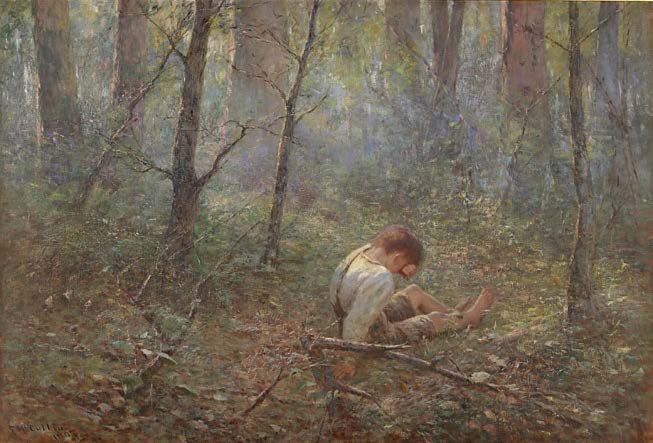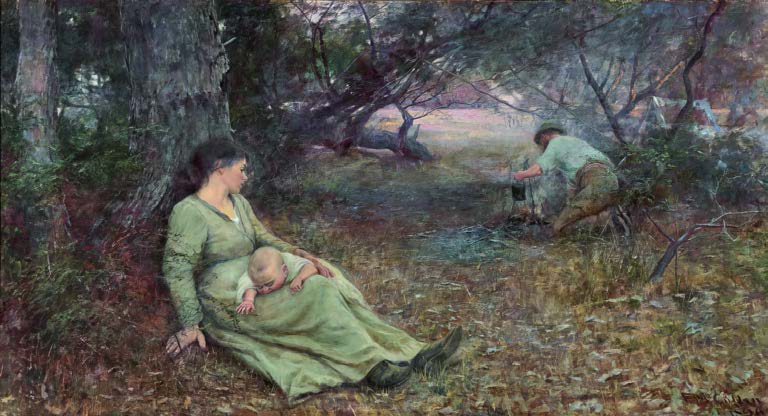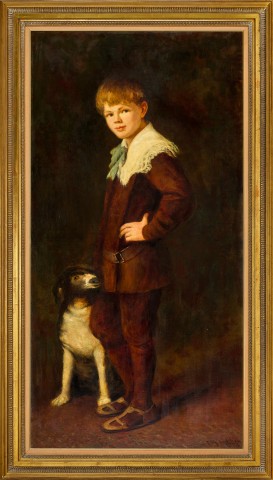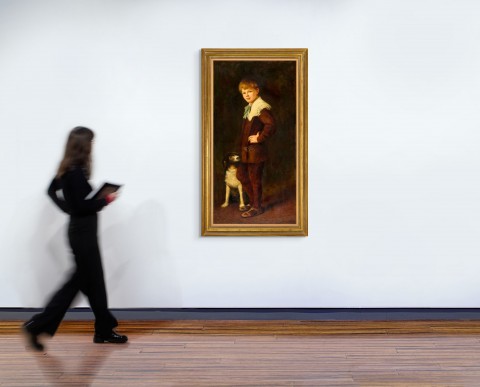Portrait of the artist’s son John [Sydney], 1903
Frederick Mccubbin
oil on canvas
137.5 x 70.0 cm
signed and dated lower right: F McCubbin / 1903
Private collection
Joseph Brown Gallery, Melbourne
Sir Archibald Glenn OBE, Melbourne, acquired from the above in November 1973
Thence by descent
Private collection, Melbourne
Fred and Louis McCubbin, Athenaeum Art Gallery, Melbourne, 14 August - 1 September 1912, cat. 11
Spring Collection Recent Acquisitions, Joseph Brown Gallery, Melbourne, 24 October - 7 November 1973, cat. 16 (illus. in exhibition catalogue, n.p., as 'Portrait of the Artist's son, Sidney [sic]')
The Art of the Dog, Castlemaine Art Gallery and Historical Museum, Victoria, 31 March - 27 May 2007, cat. 61
Telling Lives, Town Hall Gallery, Hawthorn Arts Centre, Melbourne, July 2007
We are grateful to Peter Perry, former Director of the Castlemaine Art Gallery and Historical Museum, for his assistance with this catalogue entry.
1.jpg

One of Australia’s most celebrated painters, Frederick McCubbin was pivotal to the development of Australian Impressionism through both his role as a founding member of the Heidelberg School and his close association with key figures of the movement, including Tom Roberts, Arthur Streeton, Charles Conder, and Louis Abrahams. Importantly, his artistic vision was also influenced by 19th century French realist painters such as Jules Bastien-Lepage and Gustave Courbet, as well as the plein air traditions and the aestheticism of James McNeill Whistler – all of which informed the stylistic development of the Heidelberg group.
In 1886, McCubbin was appointed as drawing master at the National Gallery of Victoria Art School – a role which became official in 1888 with a salary of £300 per annum, and which he held until his death in 1917. Though he maintained an active painting career, teaching became a financial necessity due to the demands of supporting a large family, comprising four sons and three daughters. Notably, several of his children would inherit his creative spirit: Louis and Sheila went on to become painters, Alexander pursued publishing, and Kathleen established herself as a writer.
One of the artist’s fondest models was his fifth child, John ‘Sydney’ McCubbin (1896 – 1954) – known affectionately as ‘Ginger’ and immortalised in the superb portrait on offer here. Born on 13 June 1896 in Brighton, Victoria, Sydney thus features in some of his father’s most iconic works, including Lost, 1907 (National Gallery of Victoria) in which – aged about ten years old – he is portrayed alone and vulnerable in the harsh Australian bushland. His youngest sister, Kathleen, later recalled that the work was painted early in the morning and captured the environment surrounding their family property at Mount Macedon, ‘Fontainebleu’.1 Sydney was also the model for the infant in On the wallaby track, 1896 (Art Gallery of New South Wales), and likewise appears in Boy flying a kite, 1909 (private collection) as well as A frosty morning (also known as Winter morning), 1910, held in the Ewing Collection at the University of Melbourne.
2.jpg

Although a subject in his father’s art, Sydney ultimately pursued a quite distinct career path in the field of science and technology. According to family accounts, particularly in Kathleen’s memoir Autumn Memories: A McCubbin Family Album, Sydney was a ‘born inventor’ and following the First World War, became deeply engaged with the emerging field of wireless radio technology.2 Inspired by Marconi’s groundbreaking discoveries, Sydney immersed himself in the study of short-wave radio, captivated by its ability to transmit signals around the globe. His innovative thinking and technical expertise quickly earned him a strong reputation in this rapidly evolving field, and by the time Sydney married in 1932, his profession was listed as ‘Radio Engineer’, reflecting his serious commitment to the discipline. At the time of his death on 26 May 1954, his occupation was formally recorded as ‘Inventor’ – a fitting tribute to a man whose mind was constantly seeking new frontiers.
Thus, while his father captured the spirit of the Australian landscape on canvas, Sydney helped explore the invisible landscape of wireless communication. Though less publicly celebrated than his father’s legacy as an educator and pioneer of national artistic identity, his achievements nevertheless exemplify the continuation of intellectual and creative inquiry within another generation of the McCubbin family.
1. Mackenzie, A., Frederick McCubbin 1855 – 1917 ‘The Proff’ and his art, 1st edition, Mannagum Press, Victoria, 1990, p. 134
2. Mangan, K., Autumn Memories A McCubbin Family Album, Georgian House, Melbourne, 1988, p. 139 – 140


